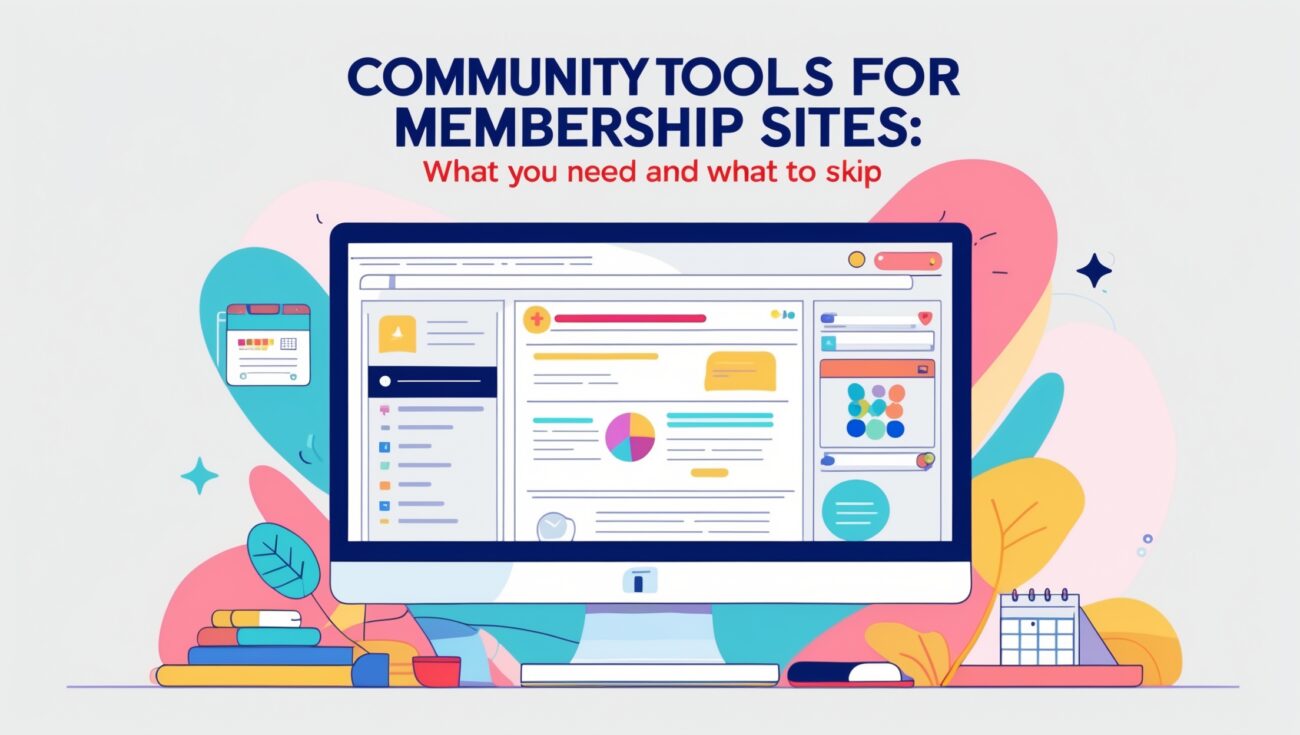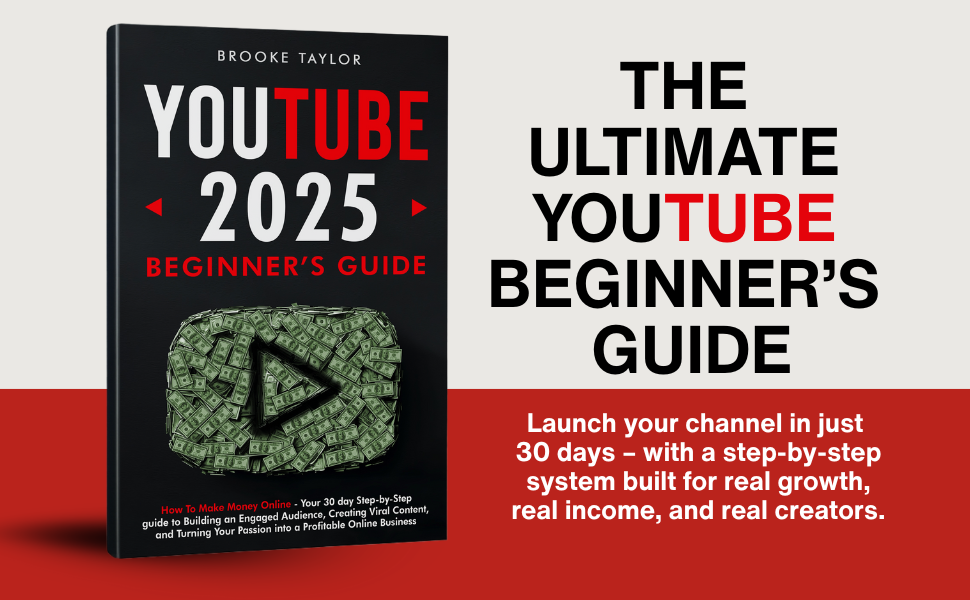Community Tools for Membership Sites: What You Need (and What to Skip)
If you’re building a membership site, you’ve probably noticed there are hundreds of platforms, tools, and plugins promising to “build your community” or “increase engagement.”
But after running multiple communities myself, I’ve learned something important: more tools don’t mean more engagement.
The truth? Most membership creators overcomplicate things. They stack tools that confuse members and burn them out.
In this guide, I’ll break down what community tools you actually need, which ones to skip, and how to build a simple system that helps your members stay active and happy — without losing your mind over tech.
If you want a simple, all-in-one community system that handles everything — courses, engagement, payments, and leaderboards — I recommend starting with Skool.

Table of Contents
Why Community Tools Matter for Membership Success
When someone joins your membership, what keeps them around? It’s not just your content.
People stay because they feel connected — to you, your mission, and others on the same path.
That connection is built through your community system — the platform where members interact, learn, and grow together.
If your setup is clunky or scattered across multiple tools, people get frustrated fast.
That’s why choosing the right community tools isn’t just a technical decision — it’s a retention strategy.
The Problem with Most Community Platforms
Before diving into what to use, let’s talk about what not to do.
Most creators make one of these three mistakes:
- They chase features instead of outcomes.
They want automation, funnels, badges, live chat, AI bots — but forget why members joined: transformation and connection. - They use too many disconnected tools.
Slack for chat. Notion for notes. Kajabi for courses. Stripe for payments. Zoom for calls.
The result? A messy Frankenstein of tech that drains time and money. - They don’t build community rhythm.
Even the best tool won’t save you if you don’t have engagement systems — weekly prompts, challenges, and feedback loops.
Let’s fix all three by looking at what you actually need.
The 4 Core Tools Every Membership Community Needs
You can build an entire profitable membership business with just four categories of tools.
Let’s go one by one.
1. A Platform to Host Your Members
Your platform is your home base. It’s where conversations happen, where you post updates, and where members log in daily.
You have a few options here, but not all are equal.
What You Need
- A clean interface (no learning curve)
- Combined community + course experience
- Built-in notifications and gamification
- Easy payment integration
What to Skip
- Platforms that require multiple logins
- Complicated setup that feels like a corporate intranet
- Systems that depend on third-party integrations for basics like messages or leaderboards
My Recommendation: Skool
After trying Slack, Circle, and Kajabi, I ended up using Skool.
Here’s why it works:
- Combines community, courses, and points all in one dashboard
- Members love its simple design and leaderboard system
- Setup takes less than an hour
- You can monetize directly inside the platform
I’ve used it to manage free groups, paid memberships, and coaching programs — and it consistently gets the best engagement.
2. A Tool for Content Delivery (Courses or Training)
If your membership includes training videos, lessons, or challenges, you’ll need a way to host them.
What You Need
- Organized structure (modules or lessons)
- Video uploads or embeds (from Loom, YouTube, or Vimeo)
- Ability to track completion
- Easy linking between community and lessons
What to Skip
- Course systems separated from your main community (people won’t switch back and forth)
- Complicated LMS systems meant for universities
- Platforms that hide content behind too many clicks
Simplest Setup
Use Skool’s built-in Classroom. It keeps learning and discussion in the same place, so when someone finishes a lesson, they can immediately discuss it in the group — reinforcing learning and connection.
If you’re not using Skool, you can use Podia, Teachable, or Systeme.io, but you’ll lose the seamless community integration.
3. A Communication & Automation System
Even if your community platform handles posts and discussions, you still need to stay connected outside it — especially for onboarding, reminders, and re-engagement.
What You Need
- An email system for updates and automation
- Ability to tag and segment members (active vs inactive)
- Simple broadcast feature for announcements
What to Skip
- Using DMs only (inefficient)
- Overcomplicated CRMs unless you’re running a huge business
- Platforms that charge extra just for sending more emails
Best Tools
If you’re starting lean, go with ConvertKit or Systeme.io.
Both let you build automated welcome sequences that say:
“Hey, welcome to our community! Here’s where to start, and here’s your first lesson.”
That personal touch keeps new members engaged before they even log in.
4. A Payment + Access System
If your membership is paid, your payment system needs to be reliable, automated, and integrated.
What You Need
- Recurring billing setup (monthly/yearly)
- Automatic access upon payment
- One dashboard for refunds or cancellations
What to Skip
- Manual payment setups via CashApp, Venmo, or PayPal DMs
- Systems that don’t automatically remove access on cancellation
- Hidden processing fees
Ideal Setup
With Skool, you can handle payments and access in one step. Members pay → get instant access → system tracks everything automatically.
No more juggling Stripe links or Google Sheets to manage subscriptions.
Optional (But Helpful) Tools for Growth
Once your foundation is solid, you can add tools for growth — but only if they serve a clear purpose.
1. Landing Page Builder
If you want a custom page to describe your community, tools like Systeme.io or Framer work well.
Keep it minimal:
- Headline (the promise)
- Short video or image
- Benefits list
- Button to “Join the Community” → Skool link.
2. Analytics Tracker
Use Google Analytics or Plausible.io to track traffic, sign-ups, and drop-off points.
This helps you see which content or ads bring the most members.
3. Meeting/Call Integration
You can embed Zoom or Google Meet links into your Skool events or announcements.
No need for extra scheduling software unless you host multiple calls per week.
4. Content Scheduler (Optional)
If you want to pre-plan posts, you can create a Notion board or Trello calendar.
But remember: real engagement comes from spontaneous conversations, not just scheduled posts.
What Tools You Should Skip Altogether
After running and auditing dozens of communities, here’s what usually becomes unnecessary (and sometimes harmful):
- Separate Chat Platforms (Discord, Slack, WhatsApp)
They fragment communication and distract from your main hub. - Too Many Automations
Over-automation kills human connection. Members want to feel seen, not managed by bots. - Gamification Overload
A little competition is great — too much feels like school. - Multiple Dashboards
Members shouldn’t have to log into five places to engage. Simplicity wins.
My Personal Setup (Lean + Effective)
When I started building communities, I tried everything. Kajabi, Circle, Mighty Networks, and even Discord.
It was chaos. Too many tools. Too many links.
Now my setup is simple:
| Purpose | Tool | Why It Works |
|---|---|---|
| Community + Courses | Skool | Combines both perfectly |
| Email Automation | ConvertKit | Sends onboarding + engagement emails |
| Payment | Skool Payments (Stripe) | Handles recurring billing automatically |
| Calls & Events | Zoom (embedded in Skool) | Smooth live sessions |
| Analytics | Google Analytics | Tracks visitor flow |
That’s it. Five tools — and zero chaos.
Building Engagement Without Overwhelm
The best community tools won’t matter if you don’t have systems for engagement.
Here’s what works for me:
1. Welcome Flow
Use Skool’s Classroom to host a short 3-lesson onboarding:
- Lesson 1: “Welcome + How to Navigate the Community”
- Lesson 2: “Post Your Intro!”
- Lesson 3: “How to Get the Most from This Membership”
Then tag new members and welcome them publicly. That instant recognition makes them feel seen.
2. Weekly Rituals
Create rhythm:
- Monday: Motivation or goals post
- Wednesday: Resource share or poll
- Friday: Wins and gratitude thread
Consistency builds familiarity — familiarity builds belonging.
3. Progress Loops
Reward engagement with levels or shoutouts.
For example:
“Level 3 gets early access to my next workshop!”
Gamification done right encourages participation, not competition.
The Cost of Over-Tooling
Let’s talk money.
The average creator using Kajabi + Slack + Stripe + Zoom + Zapier pays over $300 per month — not counting time spent managing all of it.
Compare that to Skool’s $99/month, which covers everything — courses, community, payments, and leaderboard.
That’s not just a cost saving — it’s mental clarity.
When your setup is simple, you can focus on what actually grows revenue: relationships and retention.
Retention and Simplicity Go Hand in Hand
A confused mind doesn’t buy.
A confused member doesn’t engage.
When your members can easily log in, watch lessons, comment, and feel progress, they stay.
When you bury them in apps and integrations, they quietly leave.
That’s why the most successful communities — from business masterminds to health programs — run on simple, user-friendly systems.
How to Audit Your Current Tools
If you already have a membership running, here’s how to clean it up:
- List Every Tool You Use
Include everything — email software, chat apps, course platforms, payment tools, analytics, etc. - Ask: Does This Serve Members or Me?
If a tool only helps you “feel organized” but confuses members, remove it. - Track Logins and Engagement
If less than 40% of members use a certain feature, it’s not worth keeping. - Migrate Gradually
Move your lessons and members into one unified platform.
I recommend Skool because the migration process is clean — upload videos, import members, and you’re done.
What Big Communities Get Right
If you study large, thriving communities — from coaching programs to business masterminds — you’ll notice a few patterns:
- They use one home base (usually Skool or Circle).
- They build in accountability. Members check in weekly.
- They celebrate progress publicly.
- They automate onboarding but personalize feedback.
That blend of automation + authenticity is what keeps members from leaving.
Community Tools That Scale With You
As your membership grows, you can layer in extra tools only when needed:
- Zapier – to connect Skool with other apps (optional)
- Stripe Reports – to track revenue growth
- Canva – for branded visuals and banners
- Loom – for quick personalized video messages
These enhance your experience but shouldn’t replace your core tools.
Final Thoughts: Less Software, More Connection
At the end of the day, your members don’t join for fancy features — they join for transformation.
The right community tools help you deliver that transformation smoothly, while the wrong ones distract from it.
So remember:
- Focus on connection over complexity.
- Build systems that feel human, not robotic.
- Use one clean hub instead of 10 disconnected tools.
That’s how you create a membership that lasts.
If you’re ready to simplify your community, host your lessons, and manage payments all in one place — try Skool.
It’s the cleanest, most human-centered platform I’ve used for running memberships and courses.







